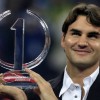Roger Federer set a new record for most total weeks as the No. 1 tennis player in the ATP rankings Monday when he sat in the top perch of men’s tennis for a record 287th week, one more week than Pete Sampras held the top ranking during his storied career. “Being No. 1 is fantastic,” Federer said of the top ranking to Rene Stauffer in the book Roger Federer: Quest for Perfection. “I recommend it to anybody.”
Federer first attained the top ranking on February 2, 2004, the Monday after winning his second major singles title at the Australian Open. The following is an excerpt from the chapter called “No. 1” in Stauffer’s book on Federer Quest for Perfection available here in hard copy and in electronic KINDLE format from amazon.com http://www.amazon.com/gp/product/0942257723?ie=UTF8&tag=newchapre-20&linkCode=shr&camp=213733&creative=393185&creativeASIN=0942257723&ref_=sr_1_1&keywords=Roger%20Federer%20Quest%20for%20Perfection&qid=1342528857&sr=8-1 or here via the publisher at www.NewChapterMedia.com
In his autobiography You Cannot Be Serious, three-time Wimbledon champion John McEnroe compared reaching the No. 1 world ranking to climbing Mount Everest. “The very top, like the summit of Everest, is weird territory, impossible to understand unless you’ve actually been there,” he said. The New Yorker, who put an end to the Björn Borg era, concurred with the late Arthur Ashe, in the statement that there was “just as much difference between No. 10 in the world and No. 5 as there was between No. 100 and No. 10. Going from No. 5 to No. 4, he (Ashe) said, is like going from No. 10 to No. 5. And from there on up is inconceivable.”
Roger Federer agreed with the assessment. “It’s a long way to No. 1. You have to overcome many obstacles to get there,” he said in spring of 2004. “I did it and now I have a lot of confidence.” He said that it was only because of winning at Wimbledon, which released the enormous pressure of finally winning a Grand Slam event, that he was able to play so freely and without pressure in Houston and Melbourne. He no longer saw any reason to keep him from winning further major titles.
At 22 years and five months old, Federer was not the youngest world No. 1. Lleyton Hewitt, Jimmy Connors, Björn Borg, John McEnroe, Jim Courier, Pete Sampras, Marat Safin and Andy Roddick were all younger when they first made their appearances at the top spot. But Federer reached No. 1 before Boris Becker, Stefan Edberg, Ivan Lendl and Andre Agassi. As one of only three German speaking world-ranked No. 1 players (after Boris Becker and Thomas Muster), Federer could appreciate his status that was denied him in 2003. A childhood dream that just barely eluded him in the past months now was a reality. It was by no means a matter of course that he would flourish as the top-ranked player. The No. 1 ranking was a burden for many of his predecessors.
The hunter became the hunted, the pursuer the pursued, the challenger the challenged. The No. 1 ranking also involved additional duties as the most important representative of the sport. It is expected that the world No. 1 shaped opinions on the sport. His word pulled weight and extra demands and attention made the world No. 1 constantly in demand. He stands at the center of the sport and is chased and surrounded by the media, fans and tournament directors, while also having the burden of continuing his training and maintaining his results to hold the No. 1 ranking.

Nonetheless the No. 1 ranking for most is the ultimate career goal—the fulfillment of a long-nurtured dream. Everybody who reaches it for the first time finds themselves at the end of a road and are forced to re-orient themselves. Not everybody copes well with the “No. 1” drug. It’s not a bad life being ranked No. 2, No. 3 or No. 5—and it is much more relaxed. Since the ATP rankings were introduced in 1973, many of the 22 players who achieved the No. 1 ranking disappeared shortly after attaining the top spot. Australian Patrick Rafter, Spaniards Carlos Moya and Juan Carlos Ferrero, the Chilean Marcelo Rios, the Austrian Thomas Muster and the Russian Yevgeny Kafelnikov were all only able to maintain the No. 1 ranking for less than a period of 10 weeks.
Federer, however, did not see himself at the end of a road but at the beginning of a new one. For him, it was immediately clear that he wanted to remain at the top as long as possible. This was his new mission that he had to sacrifice for and for which he had to set priorities. Unfortunately, the goal of maintaining the No. 1 ranking came, eventually, at the expense of Davis Cup. “Being No. 1 is fantastic. I recommend it to anybody,” he said once. “I feel much better than when I was No. 5 or No. 6. I now play with much more confidence not only because I win a lot of matches and tournaments, but because I know no one can say that they are better than me. Perhaps on a certain day—but that’s not enough to take the No. 1 position away from me.”
Federer confessed that he had no trouble with the expectations and increased hoopla of being the top man in men’s tennis. When asked at the German Open in Hamburg if he liked being popular, he frankly confessed, “I like being the star. I love being the magnet to the public’s attention.”
